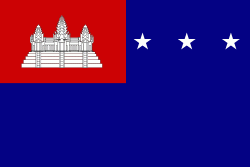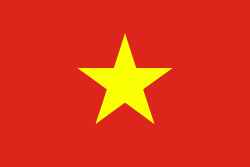Central Khmer language
Khmer (ខ្មែរ, Khmêr ) is an Austroasiatic language spoken by the Khmer people, and the official and national language of Cambodia. Khmer has been influenced considerably by Sanskrit and Pali, especially in the royal and religious registers, through Hinduism and Buddhism. It is also the earliest recorded and earliest written language of the Mon–Khmer family, predating Mon and Vietnamese, due to Old Khmer being the language of the historical empires of Chenla, Angkor and, presumably, their earlier predecessor state, Funan.
The vast majority of Khmer speakers speak Central Khmer, the dialect of the central plain where the Khmer are most heavily concentrated. Within Cambodia, regional accents exist in remote areas but these are regarded as varieties of Central Khmer. Two exceptions are the speech of the capital, Phnom Penh, and that of the Khmer Khe in Stung Treng province, both of which differ sufficiently enough from Central Khmer to be considered separate dialects of Khmer.
Outside of Cambodia, three distinct dialects are spoken by ethnic Khmers native to areas that were historically part of the Khmer Empire. The Northern Khmer dialect is spoken by over a million Khmers in the southern regions of Northeast Thailand and is treated by some linguists as a separate language. Khmer Krom, or Southern Khmer, is the first language of the Khmer of Vietnam, while the Khmer living in the remote Cardamom Mountains speak a very conservative dialect that still displays features of the Middle Khmer language.
Khmer is primarily an analytic, isolating language. There are no inflections, conjugations or case endings. Instead, particles and auxiliary words are used to indicate grammatical relationships. General word order is subject–verb–object, and modifiers follow the word they modify. Classifiers appear after numbers when used to count nouns, though not always so consistently as in languages like Chinese. In spoken Khmer, topic-comment structure is common, and the perceived social relation between participants determines which sets of vocabulary, such as pronouns and honorifics, are proper.
Khmer differs from neighboring languages such as Burmese, Thai, Lao, and Vietnamese in that it is not a tonal language. Words are stressed on the final syllable, hence many words conform to the typical Mon–Khmer pattern of a stressed syllable preceded by a minor syllable. The language has been written in the Khmer script, an abugida descended from the Brahmi script via the southern Indian Pallava script, since at least the 7th century. The script's form and use has evolved over the centuries; its modern features include subscripted versions of consonants used to write clusters and a division of consonants into two series with different inherent vowels.
Khmer is a member of the Austroasiatic language family, the autochthonous family in an area that stretches from the Malay Peninsula through Southeast Asia to East India. Austroasiatic, which also includes Mon, Vietnamese and Munda, has been studied since 1856 and was first proposed as a language family in 1907. Despite the amount of research, there is still doubt about the internal relationship of the languages of Austroasiatic.
Diffloth places Khmer in an eastern branch of the Mon-Khmer languages. In these classification schemes Khmer's closest genetic relatives are the Bahnaric and Pearic languages. More recent classifications doubt the validity of the Mon-Khmer sub-grouping and place the Khmer language as its own branch of Austroasiatic equidistant from the other 12 branches of the family.
The vast majority of Khmer speakers speak Central Khmer, the dialect of the central plain where the Khmer are most heavily concentrated. Within Cambodia, regional accents exist in remote areas but these are regarded as varieties of Central Khmer. Two exceptions are the speech of the capital, Phnom Penh, and that of the Khmer Khe in Stung Treng province, both of which differ sufficiently enough from Central Khmer to be considered separate dialects of Khmer.
Outside of Cambodia, three distinct dialects are spoken by ethnic Khmers native to areas that were historically part of the Khmer Empire. The Northern Khmer dialect is spoken by over a million Khmers in the southern regions of Northeast Thailand and is treated by some linguists as a separate language. Khmer Krom, or Southern Khmer, is the first language of the Khmer of Vietnam, while the Khmer living in the remote Cardamom Mountains speak a very conservative dialect that still displays features of the Middle Khmer language.
Khmer is primarily an analytic, isolating language. There are no inflections, conjugations or case endings. Instead, particles and auxiliary words are used to indicate grammatical relationships. General word order is subject–verb–object, and modifiers follow the word they modify. Classifiers appear after numbers when used to count nouns, though not always so consistently as in languages like Chinese. In spoken Khmer, topic-comment structure is common, and the perceived social relation between participants determines which sets of vocabulary, such as pronouns and honorifics, are proper.
Khmer differs from neighboring languages such as Burmese, Thai, Lao, and Vietnamese in that it is not a tonal language. Words are stressed on the final syllable, hence many words conform to the typical Mon–Khmer pattern of a stressed syllable preceded by a minor syllable. The language has been written in the Khmer script, an abugida descended from the Brahmi script via the southern Indian Pallava script, since at least the 7th century. The script's form and use has evolved over the centuries; its modern features include subscripted versions of consonants used to write clusters and a division of consonants into two series with different inherent vowels.
Khmer is a member of the Austroasiatic language family, the autochthonous family in an area that stretches from the Malay Peninsula through Southeast Asia to East India. Austroasiatic, which also includes Mon, Vietnamese and Munda, has been studied since 1856 and was first proposed as a language family in 1907. Despite the amount of research, there is still doubt about the internal relationship of the languages of Austroasiatic.
Diffloth places Khmer in an eastern branch of the Mon-Khmer languages. In these classification schemes Khmer's closest genetic relatives are the Bahnaric and Pearic languages. More recent classifications doubt the validity of the Mon-Khmer sub-grouping and place the Khmer language as its own branch of Austroasiatic equidistant from the other 12 branches of the family.
Country
-
Khmer Republic
The Khmer Republic (សាធារណរដ្ឋខ្មែរ, ; République khmère) was a Cambodian state under the United States-backed military dictatorship of Marshal Lon Nol from 1970 to 1975. Its establishment was formally declared on 9 October 1970, following the 18 March 1970 coup d'état which saw the overthrow of Norodom Sihanouk's government and the abolishment of the Cambodian monarchy.
The main cause of the coup was Norodom Sihanouk's tolerance of North Vietnamese military activity within Cambodia's borders; Vietnamese communist forces had gained de facto control over vast areas of eastern Cambodia as a result. Another important factor was the dire state of the Cambodian economy, an indirect result of Sihanouk's policies of pursuing neutrality. -
Vietnam
Vietnam or Viet Nam (Việt Nam, ), officially the Socialist Republic of Vietnam, is a country in Southeast Asia. It is located at the eastern edge of mainland Southeast Asia, with an area of 311699 km2 and population of 96 million, making it the world's sixteenth-most populous country. Vietnam borders China to the north, and Laos and Cambodia to the west. It shares maritime borders with Thailand through the Gulf of Thailand, and the Philippines, Indonesia, and Malaysia through the South China Sea. Its capital is Hanoi and its largest city is Ho Chi Minh City (informal popular name is Saigon).
Vietnam was inhabited by the Paleolithic age, with states established in the first millennium BC on the Red River Delta in modern-day northern Vietnam. The Han dynasty annexed Northern and Central Vietnam under Chinese rule from 111 BC, until the first dynasty emerged in 939. Successive monarchical dynasties absorbed Chinese influences through Confucianism and Buddhism, and expanded southward to the Mekong Delta, conquering Champa. The Nguyễn—the last imperial dynasty—surrendered to France in 1883. Following the August Revolution, the nationalist Viet Minh under the leadership of communist revolutionary Ho Chi Minh proclaimed independence from France in 1945.
